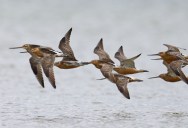The Bird That Flew From Alaska To Tasmania Without Stopping
by Trisha Leigh
Animals of all kinds are capable of amazing mental and physical feats. Now there’s a new world record for the longest one-way, no-landing migration – and this bar-tailed godwit really went the extra mile (or extra 700km, to be exact).
The bird flew a total of 8,435 miles, from Alaska to Ansons Bay, Tasmania.

Image Credit: Paul van de Velde
Scientists were thrilled to not only be able to measure the feat, but to be able to catalogue the threats migratory birds like the godwit face on their exhausting treks.
Hundreds if species breed during the brief Alaskan summer before retiring to the Southern hemisphere with the warmer weather. The godwit, though, is one of only a handful of species that don’t make a single stop along the way.
According to Sean Dooley of BirdLife Australia, Tasmania is at the far edge of the godwit’s breeding grounds, so we can expect this record to stand for some time.
Sadly, development that is desecrating coastal wetlands all over the world is probably the biggest threat to all species of migratory birds.

Image Credit: iStock
The birds are tracked for the duration of their journeys with satellites, which give scientists great insight into the process.
“We used to think they stopped on route. But there are not many places to land mid-Pacific. They are generally not good feeding places for these birds.”
What they don’t know for sure is how these migratory birds know where to go, or if they sometimes veer off the intended course.
“They’re definitely responsive to atmospheric conditions. We’ve seen some heading into Moreton Bay and encountering bad weather and backtracking a long way.”

Image Credit: iStock
The birds prep for their long flights by gorging on bristleworms and molluscs to the point that their digestive organs reduce in size to make room for the extra fat.
After that, they take off for lands unknown, although signs certainly point to their being confident in where they’re heading and why they’re going – even if they have no way of knowing what they’ll find when they get there.
Categories: ANIMALS
Tags: · bar tailed godwit, longest migratory bird flight, top, world record migratory bird

Sign up to get our BEST stories of the week straight to your inbox.




